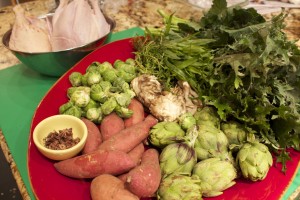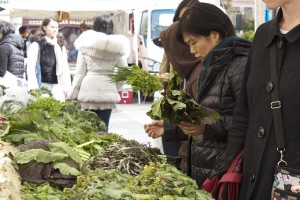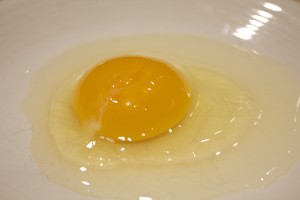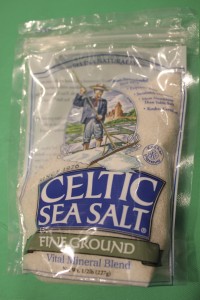
|
Eating for Radiant Skin: Part 1 I recently gave a lecture to some folks at Beauty Bank, a division of Estée Lauder, on eating for healthy skin. We then cooked a delicious luncheon that was rich in anti-oxidants and phytochemicals. Preparing the lecture got me thinking a lot about free radical damage and what contributes to good skin from the inside out. There’s so much to say about this, that I’ve divided it into three parts. Part one is simply the basics of a good diet. While individual components may vary, there are some general principles that are applicable to all. The Quality of Food Counts Eat whole foods rather than refined. Whole foods are the edible parts of foods that are as close to their natural state as possible. Here’s a visual on whole foods: Whole foods should be prepared in a way that retains enough nutritional value to be supportive of health. Beans and grains, for instance, should be soaked overnight (with juice of 1/2 lemon) to improve digestibility. Nuts should be soaked if possible. Whole foods can be puréed into a soup – it’s still whole – but a juice, although nutritious in some ways, is not a whole food. (More about this in part two.) Refined foods have been processed so that most of the nutrients have been stripped away. They are nutrient thieves; they rob your body of stored nutrients in order to make the energy it takes to digest them. Refined sugar is a prime example of this. Eat Real Food, Not Fake Heres’s an example: soy sauce, called shoyu (traditionally processed soy sauce) should just have in it soy, wheat, water and salt. It takes six months for it to ferment naturally and it’s a healthful condiment. The fake varieties have caramel coloring, all kinds of additives, and have been processed overnight. They are a bottle of flavored chemicals. That’s a fake food. Most real food has a short shelf life (there are, of course notable exceptions such as vinegars, sea vegetables, and other condiments.) Food is best fresh and harvested when ripe. If possible, go to grocery stores that buy local food, or better yet, frequent a farmers market to purchase seasonal food, which happens to be in harmony with nature. Seasonal food is the freshest, most cost effective, most organic, and most flavorful. Seasonal food helps your body adapt to changes in temperature. In winter it’s time for soups and stews, grains, and root vegetables. Spring has strawberries, asparagus, and leafy greens. These help clear waste that has accumulated over winter. Summer has a large variety of wet food, juicy fruits, lettuces, and summer squash that help our bodies stay hydrated and cope with hot weather. Buy organic when possible. Organic soil is replaced by a full spectrum of nutrients. The soil in conventional farming only has nitrogen, phosphate, and potassium. This leaves me wondering what happened to the other sixty nutrients we aren’t getting. I do think local is most important when it comes to vegetables and fruits. While shopping at a green market, you have the opportunity to ask the farmer about his farming practices. He may not be certified organic, but he may be in practice, or he may spray only minimally, and he probably replenishes his soil. A good website is foodnews.org, which lists the dirty dozen produce that is most heavily sprayed as well as the cleanest fifteen fruits and vegetables that are the least sprayed. It’s important to note that GMO foods (conventional soy, corn – not the sweet corn-on-the-cob variety, and wheat) are engineered to withstand huge amounts of pesticides. So when you eat GMO foods, you are getting a pesticide load. The Most Important Foods to be High Quality: All animal foods fall into this category. Eggs, for instance provide 8 essential amino acids and they are nature’s perfect food (of course, if you’re allergic, it’s not YOUR perfect food. ) The yolk is the most nutritious part of the egg; the nutrient list reads like a multivitamin, so please, no egg white omelets! The best nutrient dense eggs are from pastured chickens, those that have been running around pecking in the ground along with their supplemental diet of feed. The best beef, chicken, lamb and dairy are from pastured animals that have been roaming around eating pasture. They should not be finished in feed lots. Grass fed really means grass finished. All animals start out on grass but a healthy animal finishes its life on grass as well. The nutrient profile in an animal that has been finished on grass is completely superior to those which have been feedlot and grain finished. Fish should come from sustainable fisheries. Salt should have a good mineral content. Unrefined sea salt has 80 trace minerals in a form easily absorbed by the today. Use the right amount of good salt to make your foods burst with flavor and avoid processed food. Share on Facebook and Twitter | Health Tips | No comments
Young Coconuts and How to Crack Them Coconut water is the liquid found inside a young coconut. Don’t mistake it for coconut milk, which comes from the meat of a mature coconut. In addition to natural sugars, which make it taste deliciously sweet, the water contains a complex array of vitamins and minerals. The nutritious beverage is high in potassium, chlorides, calcium, and magnesium. As a tree sap, coconut water is essentially the “blood” of the coconut palm. The electrolyte profile of coconut water is somewhat similar to human plasma and has been used by doctors as an intravenous solution and injected directly into the bloodstream to prevent dehydration. When freshly extracted from the coconut, the liquid is free from germs and parasites. Sure, you can buy the water in packs from the grocery store, but it’s great fun to whack open the fruit yourself. Not to mention that there’s no comparison in the flavor between the fresh and the bottled. Young coconuts are large and green off the tree, but come already shaved in this country, so thankfully, you don’t need a machete to open them. It is not difficult to open these neatly, so that you can drink the water and scoop out the soft gel-like meat. I use a serrated knife to shave around the top part of the coconut. Then I take the heel of a heavy knife. I use a cleaver and whack it a few times. I hold the coconut on an angle, which makes it really safe. The key is to whack the coconut with confidence. After three or four whacks, the lid just lifts off. I can put a straw in this and drink the liquid and use a spoon to scoop out the gel. This is the best sports drink, thirst quencher, and cooler around. The best brand of purchased young coconut products is from exoticsuperfoods.com. You can buy packs of the young meat and bottles of fresh coconut water, which is second only to the ones you crack open yourself.
Share on Facebook and Twitter | Fruit, Health Tips, ingredients, Kitchen Tips, Where To Buy (Sources) | No comments
Salt Salt draws out of food the essential flavor that would otherwise remain neutral or latent. Salting properly is what distinguishes a mediocre cook from a very good one. I love to stand around an almost finished dish with my students, adding salt in increments until the magical moment when the flavor bursts forward. After years of cooking, I still find that an exciting moment. Properly seasoned food leaves a rounded flavor on the tongue. Often before a dish is salted properly, the flavor of the food can be dull or might register only on the back receptors of the tongue. In addition, pleasantly spicy foods feel like they are overly spicy. Once the proper amount of salt is added – and that might mean the difference of only a pinch – the constituent flavors are drawn together harmoniously, and the food comes alive. In my recipes, I always indicate an amount of salt that is close to the amount that I think a given dish needs. The recipe usually needs one or two pinches more to draw out the flavors; it is impossible to include that tiny amount in the recipe, and it may vary, depending on the ingredients. I call this extra amount a “grandma pinch,” which means a good fat pinch, not a speck. If you tend to be heavy-handed, however, make your pinch a baby pinch. Many people today are afraid of seasoning their food properly because of the misconception that salt is bad for you. Nonetheless, the body needs sodium to function. It helps carry nutrients into the cells, and is the main component of the body’s extra-cellular fluids. But let’s be clear about one thing: unrefined salt is not the same as refined salt. Salt in its natural form–not altered during manufacturing–is unrefined. It is a naturally occurring complex of sodium chloride (which includes minerals such as calcium and magnesium) as well as a complete complement of essential trace minerals. Refined salt has all of its minerals removed, rendering it an essentially lifeless product. That’s why even though it has large crystals, kosher salt does not have my endorsement. (It’s appropriate for crusting fish or cleaning cast-iron skillets.) I favor the Celtic salt that has been harvested off the coast of Brittany, dried in salt pools by wind and air. I like the finely ground variety which I use in everything, including baking. The coarse ground variety is a wonderful finishing salt for when you large crystal is desirable, such as for boiled edamame. The pristine white layer that forms on the top of the salt beds is know as fleur de sel, my first choice for sprinkling on a chocolate tart. Another high quality mineral-rich salt is Himalayan pink salt. Both Celtic and Himalayan salt are both readily available in stores and online. Both will nourish the body while making your food taste delicious. It’s best to use unrefined salt, season your food until the flavor is maximized; and, to avoid getting too much sodium, stay away from processed food!
Share on Facebook and Twitter | Health Tips, salt | No comments
|








